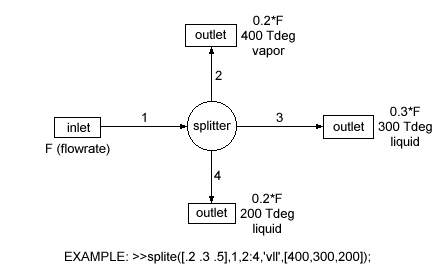
 |
function hdif=splite(t,in,out,s,tmp)
% splite: energy-balance splitter module
% function hdif=splite(t,in,out,s,tmp)
% Argument List
% Argument Gives
% t the fraction of the inlet stream
% that goes to each exit stream.
% in the index of the inlet stream.
% out the indices of the exit streams.
% s the states of the exit streams.
% tmp the temperatures of the exit streams.
% The last two arguments are optional. Without them this works as a
% normal splitter. With them splite can be used as a sort of heat
% exchanger on the exit streams.
%
% Ex: splite([.2 .2 .2 .2 .2],1,2:6)
% would split stream 1 into 5 equal parts in streams 2 through 6,
% all with the same state and temperature as stream 1.
% Ex: splite([.2 .3 .5],1,2:4,'vvl',[400 300 200])
% would split stream 1 into streams 2, 3 and 4.
% Stream 2 would get 20% of the flow, as a vapor at 400 Tdeg,
% stream 3 would get 30% as vapor at 300 Tdeg,
% and stream 4 would get the remaining 50% as liquid at 200 Tdeg.
%
% Splite returns the enthalpy difference between the inlet and outlet
% streams, which should be zero unless the last two arguments
% are given.
%
% For additional help and picture of Ex. #2 , see PICSPLITE
%JWD, TYLC
%
global ne
lt=length(t);
if length(out)~=lt
disp('Your t and out vectors are not the same length in splite')
return
end
if sum(t)~=1.0
disp('The t vector does not sum to 1 in splite')
return
end
if nargin<5
tmp=ne(in,1)*ones(1,lt);
if nargin<4
sl='slv';
s=sl((ne(in,2)+1)*ones(1,lt));
end
end
[nr,nc]=size(ne);
j=find(ne(in,4:nc));
for i=1:lt
setne(s(i),out(i),tmp(i),t(i)*ne(in,j+3),j)
end
hdif=sum(ne(out,3))-ne(in,3);
return
Also see The Splitter Function: splite. Back to Chapter 5.